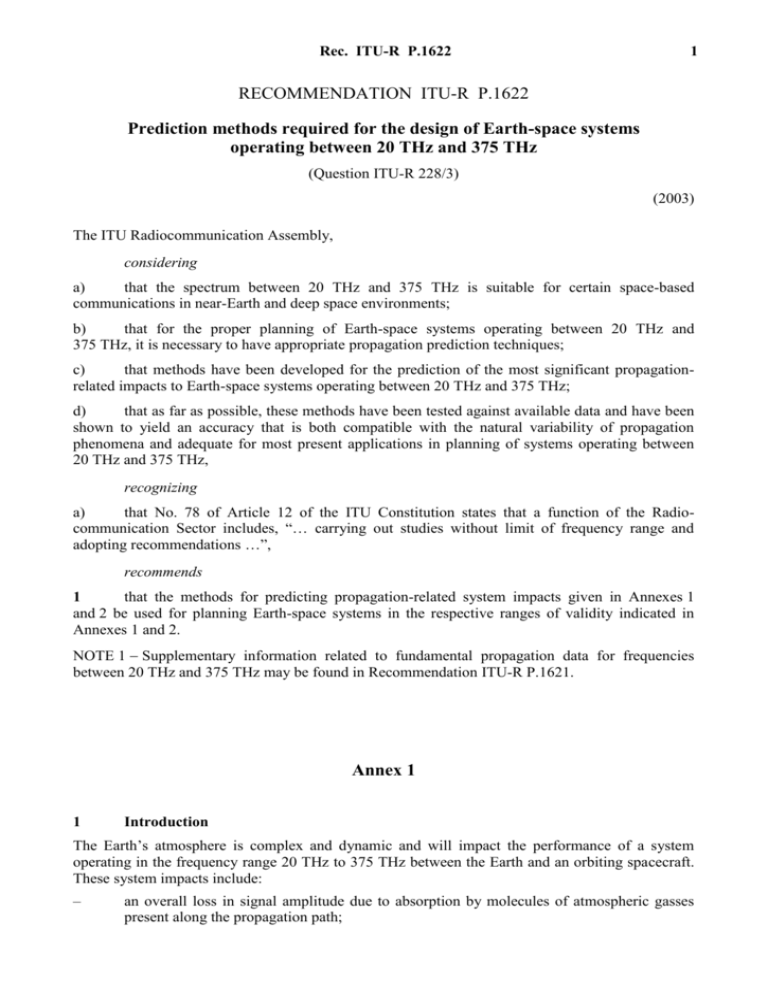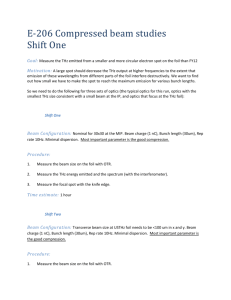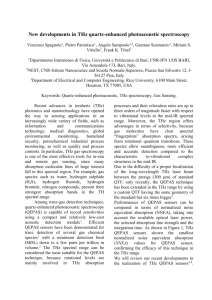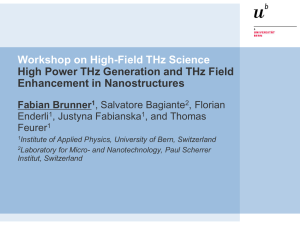4 Effects of turbulence on systems operating between 20 THz
advertisement

Rec. ITU-R P.1622 1 RECOMMENDATION ITU-R P.1622 Prediction methods required for the design of Earth-space systems operating between 20 THz and 375 THz (Question ITU-R 228/3) (2003) The ITU Radiocommunication Assembly, considering a) that the spectrum between 20 THz and 375 THz is suitable for certain space-based communications in near-Earth and deep space environments; b) that for the proper planning of Earth-space systems operating between 20 THz and 375 THz, it is necessary to have appropriate propagation prediction techniques; c) that methods have been developed for the prediction of the most significant propagationrelated impacts to Earth-space systems operating between 20 THz and 375 THz; d) that as far as possible, these methods have been tested against available data and have been shown to yield an accuracy that is both compatible with the natural variability of propagation phenomena and adequate for most present applications in planning of systems operating between 20 THz and 375 THz, recognizing a) that No. 78 of Article 12 of the ITU Constitution states that a function of the Radiocommunication Sector includes, “… carrying out studies without limit of frequency range and adopting recommendations …”, recommends 1 that the methods for predicting propagation-related system impacts given in Annexes 1 and 2 be used for planning Earth-space systems in the respective ranges of validity indicated in Annexes 1 and 2. NOTE 1 Supplementary information related to fundamental propagation data for frequencies between 20 THz and 375 THz may be found in Recommendation ITU-R P.1621. Annex 1 1 Introduction The Earth’s atmosphere is complex and dynamic and will impact the performance of a system operating in the frequency range 20 THz to 375 THz between the Earth and an orbiting spacecraft. These system impacts include: – an overall loss in signal amplitude due to absorption by molecules of atmospheric gasses present along the propagation path; 2 Rec. ITU-R P.1622 – an overall loss in signal amplitude and an increase in background noise due to scattering by particles ranging in size from fractions of a wavelength to many wavelengths present along the propagation path; – fluctuations in the received amplitude and phase of the signal due to turbulence caused by thermal variations in the atmosphere. The representative techniques and equations required to carry out the necessary prediction methods are presented in the following sections of this Annex. 2 Absorption losses Calculations of atmospheric absorption are possible using a line-by-line method similar to that which is provided in Recommendation ITU-R P.676. However, as thousands of individual lines are present across the spectral range from 10 THz to 1 000 THz (30 m to 0.3 m), such a method is computationally intensive and cumbersome. The windows of low atmospheric absorption are identified within the astronomical community with standardized filters as described in Table 1. The centre frequencies of these filters provide an estimate of the regions of spectrum usable for communication along Earth-space paths in terms of the absorptive characteristics of the atmosphere only. As absorption is dependent, in part on local temperature, pressure, and atmospheric chemistry, the bandwidth of the filters does not necessarily correspond with the bandwidth of the regions of low atmospheric absorption. The four highest frequency bands represent a continuum of visible and ultraviolet spectrum with relatively low atmospheric absorption rather than distinct low absorption regions. Measurements of atmospheric absorption should be conducted whenever possible prior to the deployment of an earth station. TABLE 1 Standard astronomical filters for frequencies above 15 THz Filter Q N M L L K H Centre frequency (THz) 15 30 63 79 86 136 180 Wavelength (m) 20.25 10.1 4.80 3.80 3.50 2.20 1.65 Bandwidth (THz) (m) 15.2 6.50 18.2 5.70 15.9 1.20 14.7 0.70 17.3 0.70 30.1 0.48 33.3 0.30 J IJ IS R V B U Filter Centre frequency (THz) 240 330 370 430 560 700 830 Wavelength (m) 1.25 0.90 0.80 0.70 0.54 0.43 0.36 Bandwidth (THz) (m) 74.7 0.38 90.5 0.24 115.1 0.24 138.1 0.22 93.2 0.09 164.5 0.10 163.6 0.07 Rec. ITU-R P.1622 3 3 Scattering losses Scattering is generally defined as the redirection of energy by particles present along the propagation path. The primary effects to communication systems operating at frequencies between 20 THz and 375 THz in free space appear when: – particles with a diameter approximately equal to the transmitted signal wavelength, present along the propagation path, redirect the transmitted signal away from its intended path; – particles with a diameter much smaller than the transmitted signal wavelength, present in the propagating medium, redirect extraneous energy into the intended receiver. 3.1 Attenuation of the transmitted signal due to Mie scattering Mie scattering is the predominant source of losses at frequencies below 375 THz, and is largely caused by microscopic particles of water. When local measurements characterizing the atmosphere are not available, the method described below can be used for calculating attenuation due to scattering along Earth-space paths. If measurements are available, a detailed calculation, provided in Annex 2, may be used. The following method is appropriate for earth stations located at altitudes between 0 and 5 km above sea level and between 150 THz and 375 THz, the frequencies most often associated with telecommunication through free space. The method is accurate to within approximately 0.1 dB assuming elevation angles above 45º. However, local atmospheric conditions may lead to several dBs of variability. The following parameters are required: : wavelength (m) hE : height of the earth station above mean sea level (km) : elevation angle. Step 1: Calculate the wavelength-dependent empirical coefficients: a 0.0005452 0.002 0.0038 (1a) b 0.006282 0.0232 0.0439 (1b) c 0.0282 0.101 0.18 (1c) d 0.2283 0.9222 1.26 0.719 (1d) Step 2: Calculate the extinction ratio, , from hE to : km–1 a hE3 b hE2 c hE d (2) Step 3: Calculate atmospheric attenuation due to scattering, AS, along path: AS 4.3429 sin( ) dB (3) 4 Rec. ITU-R P.1622 3.2 Increases in background noise due to Rayleigh scattered solar energy Rayleigh scattering is negligible for systems operating below 375 THz. The most significant result of Rayleigh scattering to systems operating above 375 THz is the introduction of background noise into receivers. Background noise appears in both the Earth-to-space and space-to-Earth directions. The primary noise source for earth stations operating with spacecraft comes from Rayleigh scatter of sunlight during daytime operations. Spacecraft pointed at the Earth will also encounter noise from sunlight scattered from the Earth’s surface. 4 Effects of turbulence on systems operating between 20 THz and 375 THz As discussed in Recommendation ITU-R P.1621, the magnitude of turbulence is measured in terms of a Cn2 profile. The impacts of turbulence can be generally categorized as: – amplitude scintillation caused by a redistribution of energy within the beam; – apparent changes in the angle of arrival of the incoming signal; – beam wander resulting in deflection of the beam centroid away from the axis of propagation; – beam spreading caused by unequal refraction across the wavefront resulting in decreased power in the plane of the receiving antenna’s aperture. 4.1 Amplitude scintillation Turbulence at frequencies between 150 THz and 375 THz causes Gaussian distributed fluctuations in the log-irradiance, N, of an incoming wave, called scintillation, by spatially redistributing its power across the surface of the wavefront randomly in time. The strength of scintillation is measured in terms of the variance of the beam amplitude. The following parameters are required to calculate the strength of scintillation: h0 : height of earth station above ground level (m) : wavelength : elevation angle Z: effective height of the turbulence (typically 20 000 m). Scintillation is traditionally given in terms of the variance, 2, of ln(N ) by: Z 2 7/6 11/ 6 ln N 2.253k sec Cn2 (h)h5/ 6 d h h0 where: k: wavenumber ( 2/) : wavelength (m) : zenith angle h: height above ground level (m). Np2 (4a) Rec. ITU-R P.1622 5 This is equivalent to: Z 1.924 108 Cn2 (h) (h h0 )5/ 6 d h h0 7/6 2 ln N sin 11/ 6 Np2 (4b) where the wavelength, , is in m, and the other parameters are given as above. If desired, this is easily converted to dBN of fluctuation by multiplying the coefficient in the numerator by the change-of-base ratio and a factor of 10 resulting in: Z 2 2 dB N 10 2 ln N ln( 10) 3.622 109 Cn2 (h) (h h0 )5/ 6 d h h0 7/6 sin 11/ 6 dB2 (4c) If local measurements of Cn2 are not available, the profile of Cn2 (h) in § 5.1.1 of Recommendation ITU-R P.1621 may be used. Table 2 provides examples for selected frequencies in the 10 THz to 1 000 THz (30 m to 0.3 m) 2 2 spectral region. Values of lnN and dBN for each of the frequencies are calculated assuming the turbulence structure profile provided in § 5.1.1 of Recommendation ITU-R P.1621, the aperture size is less than the atmospheric coherence length, r0, an elevation angle of 75, earth station antenna is 5.5 m above the ground, and for r.m.s. wind speed along the vertical path, vrms, of 21 m/s and 30 m/s. TABLE 2 Example scintillation statistics 4.1.1 2 σ ln N 2 σ dB N 2 σ ln N 2 σ dB N Frequency (THz) Wavelength (m) 563.9 0.532 0.23 4.41 0.36 6.88 352.9 0.850 0.14 2.58 0.21 3.98 282.0 1.064 0.10 1.93 0.16 3.12 193.5 1.55 0.07 1.29 0.10 1.93 (vrms 21 m/s) (vrms 30 m/s) Amplitude scintillation on paths in the Earth-to-space direction The variance of log-irradiance, on paths in the Earth-to-space direction, E2 s will remain small (4). Experiments have verified that there is a low probability of exceeding this limit. 2 Typically, lnN drops about two orders of magnitude as frequency increases from 24 THz to 750 THz (12.5 m to 0.4 m). Aperture averaging is generally not considered on paths in the Earth-to-space direction. A wavefront exiting the atmosphere experiences the same spatial redistribution of energy across its surface as occurs in the space-to-Earth direction. However, diffraction of the wavefront, as it propagates through space, spreads individual amplitude and phase perturbations across large areas. 6 Rec. ITU-R P.1622 Thus the phase coherence radius at the receiving aperture on a spacecraft is much larger than the probable size of the spacecraft receiver aperture ( 1 m). Therefore no aperture averaging occurs and scintillation appearing at the receiver is given by: 2 2 E s ln N Np2 (5) 2 For operation at 150 THz (2.0 m), when lnN is about 0.15, 4 dB fades occur about 1% of the time with a frequency and duration of about 150 Hz and 105 s. 4.1.2 Amplitude scintillation on paths in the space-to-Earth direction The impact of scintillation on paths in the space-to-Earth direction can be large enough to severely limit performance of receivers. If the receiver has a finite aperture larger than the atmospheric coherence length, r0, the effect of scintillation is spatially averaged over the aperture resulting in a 2 reduction of lnN . While aperture averaging can mitigate amplitude scintillation effects, the corrupted phase can significantly degrade the performance of single spatial-mode optical receiver systems such as coherent detection or preamplified direct detection. 2 The value of lnN on paths in the space-to-Earth direction, s2E , is modified by an aperture averaging factor, A. The aperture averaging factor is defined as the ratio of the variance of log-irradiance obtained from a finite size collecting aperture to the corresponding quantity obtained from a point aperture and is calculated by: Step 1: Calculate the turbulence scale height, z0, by: Z Cn2 (h)h 2 d h h z0 0 Z 2 5/ 6 Cn ( h) h d h h0 6/ 7 m (6) where: h0 : height of earth station above ground level (m) h: height above ground level (m) Z: effective height of turbulence above ground level (typically 20 000 m). Step 2: Calculate the aperture averaging factor, A, by: A 1 D 2 sin 1 1.1 107 z0 where: D: diameter of the earth station aperture (m) : elevation angle : wavelength (m). 7/6 (7) Rec. ITU-R P.1622 7 Step 3: Calculate the variance of log-irradiance on a path in the space-to-Earth direction, s2E , by: 2 2s E Aln N 4.2 Np2 (8) Angle of arrival Turbulence-induced fluctuations in the apparent angle of arrival of the received beam are due to variations in the refractive indices of the parcels of air along the propagation path. The effects of these fluctuations in the Earth-to-space direction are negligible. Typical r.m.s. angle of arrival variations are on the order of 1 rad and, thus, have little effect. However, in the space-to-Earth direction the r.m.s. fluctuations are more on the order of several rad and must be considered. The method described below can be used to calculate the variance of the angle of arrival, 2 , on paths in the space-to-Earth direction through a given turbulence profile, Cn2 , for elevation angles greater than 45. The following parameters are required: h0 : : DR : Z: height of the earth station above ground level (m) elevation angle diameter of the receiver aperture (m) the effective height of turbulence (typically 20 000 m). Step 1: Obtain the vertical turbulence profile of the atmosphere. If this long-term statistic cannot be obtained from local data sources, an estimate can be obtained from § 5.1.1 of Recommendation ITU-R P.1621. Step 2: Calculate the integrated turbulence profile, from: Z Cn (h) d h 2 m1/ 3 (9) h0 where h is the height above ground level (m). If local measurements of the integrated Cn2 profile are not available, the empirical approximation given in equations (9) to (12) of Recommendation ITU-R P.1621 provides satisfactory results for most applications. Step 3: Calculate the variance of the angle of arrival, 2 , from: 2 2.914 DR1/ 3 sin rad2 (10) Along paths in the space-to-Earth direction, the divergence of a beam and the long propagation distance through free space will make the wavefront much larger than r0 by the time it reaches the 8 Rec. ITU-R P.1622 turbulence. Therefore, the effects of the atmosphere are averaged across the width of the beam. The term for antenna size in (11) accounts for the fraction of the beam seen by the earth station. 4.3 Beam wander Beam wander is the displacement of the beam from the intended propagation direction. Beam wander is significant in the Earth-to-space direction and can be on the order of a beamwidth. At a distance L, the r.m.s. displacement of the wandering beam, rc, is given by: Z Cn (h) d h 2 rc 2 080 L h0 D1T/ 3 sin () m (11a) where: L: propagation distance from the earth station to the satellite (km) DT : diameter of the transmitting aperture (m) h0 : height of the earth station above ground level (m) h: height above ground level (m) Z: effective height of the turbulence (typically 20 000 m). The r.m.s. angular displacement, c, of the wandering beam can be calculated by removing the propagation path length from the equation: Z Cn (h) d h 2 c rc L 10 3 2.08 h0 D1T/ 3 sin () rad (11b) If local measurements of the integrated Cn2 profile are not available, the empirical approximation given in equations (9) to (12) of Recommendation ITU-R P.1621 provides satisfactory results for most applications. Beam wander in the Earth-to-space direction can potentially be mitigated through the use of multiple beams or a transmitter controlled with a tracking device. Beam wander is not a significant problem in the space-to-Earth direction. Beams travelling in this direction only propagate through turbulence in the final 10 to 20 km of the path. 4.4 Beam spreading Beam spreading is the increase in the diameter of a beam, beyond that already occurring due to divergence, as a result of propagating through turbulence in the atmosphere. Beam spreading results in a reduced power level arriving at the receiver due to the transmitted energy being spread over a larger area. However, the amount of spreading induced by the atmosphere is typically very small with respect to divergence and does not account for an appreciable loss of signal in either the Earth-to-space or space-to-Earth directions. Rec. ITU-R P.1622 9 Annex 2 Detailed calculation of attenuation due to Rayleigh and Mie scattering If local measurements characterizing the atmosphere are available, the method described below can be used for calculating attenuation along Earth-space paths. The parameters required for this model are: : wavelength (m) hE : height of the earth station above sea level (km) : elevation angle. Step 1: Calculate the coefficient of Rayleigh scattering, R, at 1 km increments from the earth station height to 30 km above sea level by: R (h) R nR (h) 103 km –1 (12) where: R : nR(h): Rayleigh scattering cross section (m2) atmospheric number density (m–3). Above 30 km, the effects of Rayleigh scattering are negligible. If no measured values of R are available, use the values for a standard reference atmosphere given in Table 3. If no measured values of nR are available, use the values for a standard reference atmosphere given in Table 4. Step 2: Calculate the coefficient of Mie (i.e. aerosol) scattering, A, at 1 km increments from the earth station height to 30 km above sea level by: (0) n A (h) A (h) A n A (0) km –1 (13) where: A(0) : aerosol scattering coefficient at sea level (km–1) nA(h) : aerosol number density h km above sea level (m–3). If no sea level measurements of A are available, use the values for a standard reference atmosphere given in Table 3. If no measured values of nA are available, use the values for a standard reference atmosphere given in Table 4. 10 Rec. ITU-R P.1622 TABLE 3 Rayleigh scattering cross sections for several wavelengths Wavelength (m) R(1) (m2) A(0)(2) (km–1) Wavelength (m) R(1) (m2) A(0)(2) (km–1) 0.50 6.735 10–31 0.167 1.06 3.320 10–32 0.113 –32 0.108 0.55 4.563 10 –31 0.158 1.26 1.600 10 0.60 3.202 10–31 0.150 1.67 5.210 10–33 0.098 0.65 2.313 10–31 0.142 2.17 1.800 10–33 0.085 0.70 1.713 10 3.50 2.681 10 –34 0.070 4.00 1.571 10 –34 0.063 –31 0.135 0.80 9.989 10 –32 0.127 0.90 6.212 10–32 0.120 (1) Values of R for wavelengths not included on the Table may be interpolated assuming a log-linear relationship. (2) Values of A(0) for wavelengths not included on the Table may be interpolated assuming a power law relationship. TABLE 4 Aerosol number densities, nA, and atmospheric number densities, nR, for several altitudes above sea level Altitude (km) nA (m–3) nR (m–3) Altitude (km) nA (m–3) nR (m–3) 0 2.0 108 2.548 1025 16 6.7 104 3.462 1024 1 8.7 107 2.312 1025 17 7.3 104 2.959 1024 2 3.8 107 2.093 1025 18 8.0 104 2.530 1024 3 1.6 107 1.891 1025 19 9.0 104 2.163 1024 4 7.2 106 1.704 1025 20 8.6 104 1.849 1024 5 3.1 106 1.532 1025 21 8.2 104 1.574 1024 6 1.3 106 1.373 1025 22 8.0 104 1.341 1024 7 4.0 105 1.227 1025 23 7.6 104 1.144 1024 8 1.4 105 1.093 1025 24 5.2 104 9.760 1023 9 5.0 104 9.713 1024 25 3.6 104 8.335 1023 10 2.6 104 8.599 1024 26 2.5 104 7.123 1023 11 2.3 104 7.586 1024 27 2.4 104 6.092 1023 12 2.1 104 6.487 1024 28 2.2 104 5.214 1023 13 2.3 104 5.544 1024 29 2.0 104 4.466 1023 14 2.5 104 4.739 1024 30 1.9 104 3.848 1023 15 4.1 104 4.050 1024 NOTE 1 Values of nA and nR at altitudes not included on the Table may be linearly interpolated. Rec. ITU-R P.1622 11 Step 3: Calculate the atmospheric extinction coefficient, T, at each altitude from the earth station height to 30 km above sea level by: T (h) R (h) A (h) km–1 (14) Step 4: Calculate the extinction ratio of the atmosphere, T , from the earth station altitude to 30 km above sea level by: T 30 T (h) h (15) h h0 where: hE : T (h) : h : height of the earth station above sea level (km) average value of T (h) and T (h – 1) (km–1) distance between h and h – 1 (km). Step 5: Calculate the total attenuation due to scatter, AS, along the Earth-space path by: 4.3429 AS 10 log 10 e T / sin T sin dB (16)







